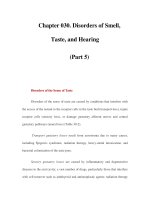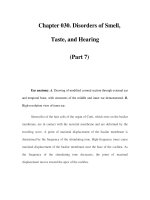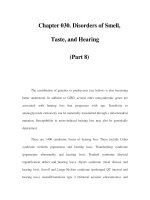Chapter 030. Disorders of Smell, Taste, and Hearing (Part 6) pot
Bạn đang xem bản rút gọn của tài liệu. Xem và tải ngay bản đầy đủ của tài liệu tại đây (55.84 KB, 5 trang )
Chapter 030. Disorders of Smell,
Taste, and Hearing
(Part 6)
Approach to the Patient: Disorders of the Sense of Taste
Patients who complain of loss of taste should be evaluated for both
gustatory and olfactory function. Clinical assessment of taste is not as well
developed or standardized as that of smell. The first step is to perform
suprathreshold whole-mouth taste testing for quality, intensity, and pleasantness
perception of four taste qualities: sweet, salty, sour, and bitter. Most commonly
used reagents for taste testing are sucrose, citric acid or hydrochloric acid, caffeine
or quinine (sulfate or hydrochloride), and sodium chloride. The taste stimuli
should be freshly prepared and have similar viscosity. For quantification, detection
thresholds are obtained by applying graduated dilutions to the tongue quadrants or
by whole-mouth sips. Electric taste testing (electrogustometry) is used clinically to
identify taste deficits in specific quadrants of the tongue. Regional gustatory
testing may also be performed to assess for the possibility of loss localized to one
or several receptor fields as a result of a peripheral or central lesion. The history of
the disease and localization studies provide important clues to the causes of the
taste disturbance. For example, absence of taste on the anterior two-thirds of the
tongue associated with a facial paralysis indicates that the lesion is proximal to the
juncture of the chorda tympani branch with the facial nerve in the mastoid.
Disorders of the Sense of Taste: Treatment
Treatment of gustatory disorders is limited. No effective therapies exist for
the sensorineural disorders of taste. Altered taste due to surgical stretch injury of
the chorda tympani nerve usually improves within 3–4 months, while dysfunction
is usually permanent with transection of the nerve. Taste dysfunction following
trauma may resolve spontaneously without intervention and is more likely to do so
than posttraumatic smell dysfunction. Idiopathic alterations of taste sensitivity
usually remain stable or worsen; zinc and vitamin therapy are of unproven value.
Directed therapy to address factors that affect taste perception can be of value.
Xerostomia can be treated with artificial saliva, providing some benefit to patients
with a disturbed salivary milieu. Oral pilocarpine may be beneficial for a variety
of forms of xerostomia. Appropriate treatment of bacterial and fungal infections of
the oral cavity can be of great help in improving taste function. Taste disturbance
related to drugs can often be resolved by changing the prescribed medication.
Hearing
Hearing loss is one of the most common sensory disorders in humans and
can present at any age. Nearly 10% of the adult population has some hearing loss,
and one-third of individuals >65 years have a hearing loss of sufficient magnitude
to require a hearing aid.
Physiology of Hearing
(Fig. 30-3) The function of the external and middle ear is to amplify sound
to facilitate mechanotransduction by hair cells in the inner ear. Sound waves enter
the external auditory canal and set the tympanic membrane in motion, which in
turn moves the malleus, incus, and stapes of the middle ear.
Movement of the footplate of the stapes causes pressure changes in the
fluid-filled inner ear eliciting a traveling wave in the basilar membrane of the
cochlea. The tympanic membrane and the ossicular chain in the middle ear serve
as an impedance-matching mechanism, improving the efficiency of energy
transfer from air to the fluid-filled inner ear.
Figure 30-3









